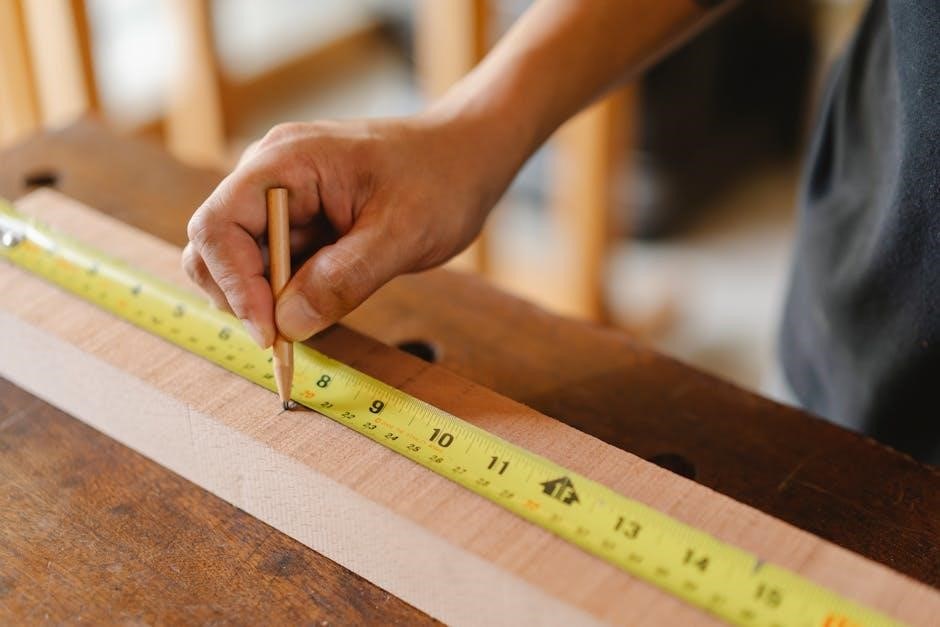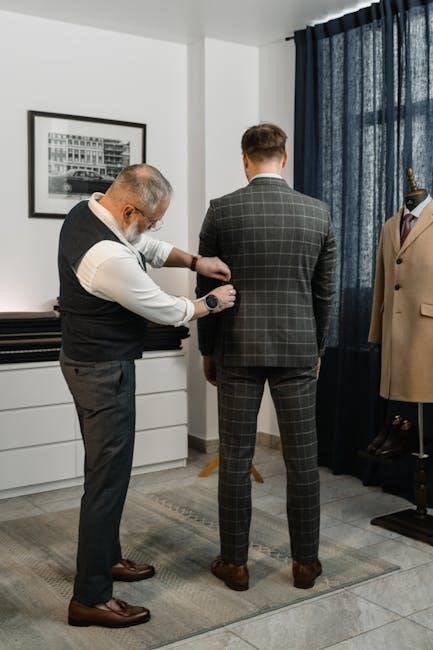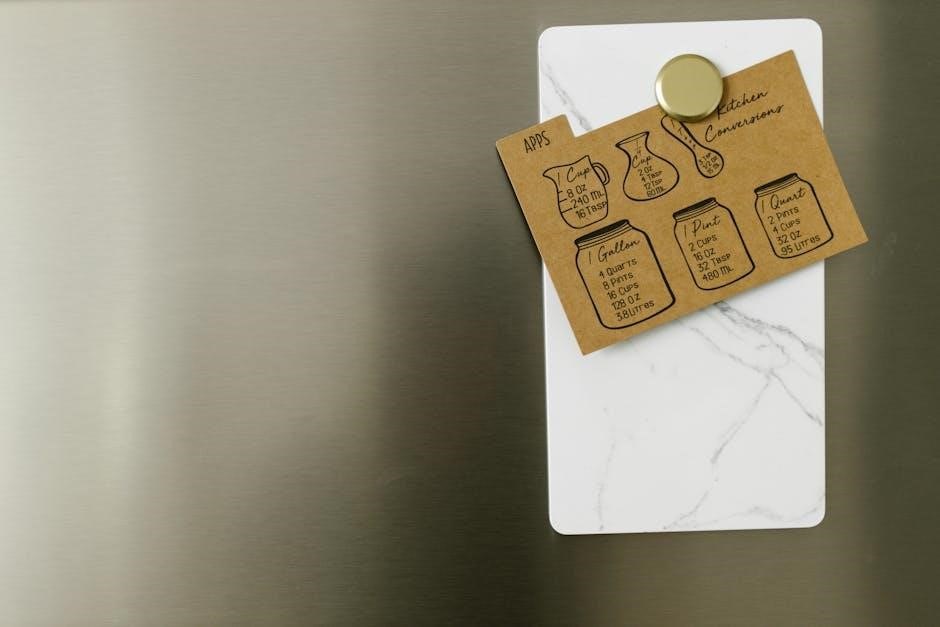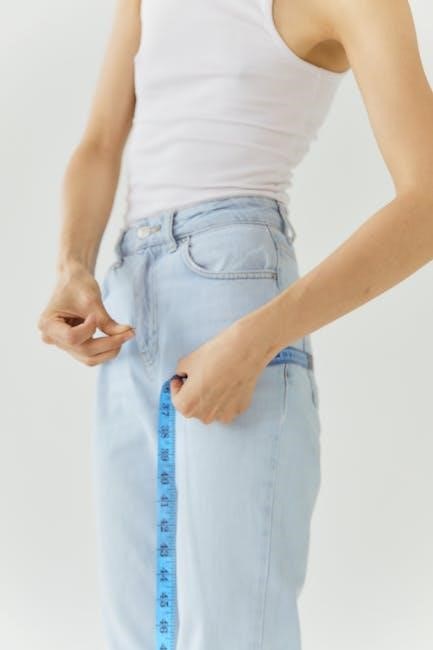This guide simplifies the process of determining your shirt size by focusing on essential measurements like neck, chest, and sleeve length. Understanding your measurements ensures a perfect fit, boosting confidence and style. Referencing brand-specific charts helps you choose the right fit and style every time.

Understanding Body Measurements for Shirt Sizing
Accurate body measurements are crucial for determining the perfect shirt size. Key measurements include neck, chest, sleeve length, and waist, ensuring a comfortable and flattering fit. Proper sizing enhances confidence and style, making it essential for every wardrobe.
Neck Measurement
Measuring your neck is the first step in determining your shirt size. To do this accurately, place a flexible measuring tape around the base of your neck, where a shirt collar would typically sit. Ensure the tape is not too tight or too loose; it should feel comfortable, just like a well-fitting shirt. The measurement should be taken with the tape positioned horizontally, avoiding any tilting or twisting. If you don’t have a measuring tape, you can use a string or ribbon to wrap around your neck and then measure its length with a ruler. Proper neck measurement is crucial as it forms the basis of your shirt size, ensuring the collar fits comfortably without being restrictive or overly loose. This measurement is especially important for dress shirts, where a precise fit around the neck is essential for a polished look. Accurate neck measurement helps you choose the right size, avoiding discomfort and ensuring a flattering fit.

Chest Measurement
Measuring your chest is a critical step in determining your shirt size. To do this accurately, wrap a flexible measuring tape around the fullest part of your chest, keeping the tape level and parallel to the floor. The tape should be snug but not tight, passing under your armpits and across your nipple line. Ensure your arms are relaxed by your sides to avoid compressing or expanding your chest. If you don’t have a measuring tape, you can use a string or ribbon to mark the circumference and then measure its length with a ruler; This measurement is essential for ensuring the shirt fits comfortably across your torso. It’s important to note that your chest measurement is the second most important factor after neck size when determining your shirt size. A proper chest measurement ensures the shirt isn’t too tight or too loose, providing a flattering and comfortable fit. Always refer to brand-specific size charts, as chest measurements can vary slightly between brands.

Sleeve Length Measurement
Measuring sleeve length is crucial for ensuring your shirt fits perfectly. To measure accurately, stand up straight and place your arm at your side with a slight bend in the elbow. The measuring tape should start at the center of the back of your neck, just below the base of the skull, and extend down to your wrist. This length determines the sleeve length of your shirt. For casual shirts, the sleeve typically ends just above the wrist bone, while dress shirts often have slightly longer sleeves that cover the wrist. It’s important to keep your arm relaxed and not stretched out during measurement, as this can lead to an inaccurate fit. Sleeve length varies between brands, so always refer to the specific size chart provided by the manufacturer. Proper sleeve length ensures comfort and a polished appearance, avoiding sleeves that are too short or overly long. This measurement, combined with others, helps create a balanced and flattering fit for any shirt style.
Waist Measurement
Measuring your waist is an essential step in determining the perfect shirt fit. The waist measurement helps ensure the shirt sits comfortably around your midsection. To measure accurately, locate your natural waistline, which is the narrowest part of your torso, typically just above your belly button. Wrap a flexible measuring tape around this area, keeping it level and parallel to the floor. The tape should not be too tight or too loose; it should feel snug but comfortable; This measurement is particularly important for shirts with a defined waist or those designed to taper slightly. For casual shirts, the waist measurement ensures the fit isn’t too boxy, while for dress shirts, it helps maintain a streamlined appearance. If your measurement falls between sizes, consider the style of the shirt and your preference for a tighter or looser fit. Accurate waist measurement ensures a balanced and flattering silhouette, complementing your body shape. This step is crucial for achieving a shirt that looks and feels great.

How to Use a Shirt Size Chart
Using a shirt size chart is straightforward. Take your body measurements, then compare them to the chart provided by the brand. This ensures the best fit based on your chest, neck, sleeve, and waist measurements. Always consider your fit preference when selecting a size.

Standard Size Charts
Standard size charts provide a universal reference for determining shirt sizes based on common body measurements. These charts typically include measurements for chest, neck, sleeve length, and shirt length, offering a consistent framework for sizing. They are widely used across brands to ensure consistency and ease of understanding.

- Chest Measurement: The most critical factor, as it determines the shirt’s fit around the torso.
- Neck Measurement: Essential for dress shirts, ensuring the collar fits comfortably.
- Sleeve Length: Measured from the center back of the neck to the wrist, ensuring sleeves are neither too short nor too long.
- Shirt Length: Varies by style, but standard charts provide average lengths for different sizes.
Standard charts often include sizes labeled as Small, Medium, Large, and Extra-Large, with corresponding numerical values in inches or centimeters. For example, a Medium size might correspond to a 38-40″ chest and a 15.5-16″ neck. Regional variations exist, with UK, EU, and US sizes differing slightly. Always compare your measurements to the chart to find the best fit, ensuring comfort and style. If your measurements fall between sizes, choose based on your preferred fit—slimmer or roomier.
Brand-Specific Size Charts
Brand-specific size charts are tailored to the unique fits and styles of individual brands, ensuring a more accurate fit for their designs. Unlike standard charts, these are customized to reflect the brand’s specific cut, fabric, and style variations. Many brands provide detailed measurements, including chest, waist, sleeve length, and shirt length, to help customers find their perfect size. These charts often cater to different fits, such as slim-fit, classic, or relaxed, making it easier to choose the right style.
- Why Use Them: Brand-specific charts account for variations in sizing between brands, ensuring a better fit compared to generic measurements.
- How to Use: Measure yourself and compare your measurements to the brand’s chart to determine the best size for your body type and preferred fit.
- Tips: If your measurements fall between sizes, consider your fit preference—slimmer for a tighter fit or larger for a looser feel.
By referencing brand-specific charts, you can avoid sizing mismatches and enjoy a shirt that fits perfectly, enhancing both comfort and style.

Choosing the Right Fit
Understanding your measurements and fit preferences is key to selecting a shirt that feels comfortable and looks great. Whether slim, classic, or relaxed, the right fit enhances confidence, style, and overall comfort.

Slim Fit Shirts
Slim fit shirts are tailored to sit close to the body, offering a modern, streamlined appearance. They are narrower in the chest, waist, and sleeves compared to classic or regular fits. This style is ideal for those who prefer a more fitted look without feeling restrictive. When choosing a slim fit, ensure accurate measurements, as they are designed to hug the body closely. Avoid wearing bulky clothing while measuring to get the best fit. Slim fit shirts are perfect for highlighting a toned physique or creating a sleek, professional look. They are versatile, suitable for both casual and formal occasions. However, if your measurements fall between sizes, consider sizing up for comfort. Always refer to brand-specific size charts, as slim fits can vary slightly between brands. Properly fitted slim shirts enhance confidence and style, making them a popular choice for many.
Classic Fit Shirts
Classic fit shirts are designed to offer a comfortable, relaxed silhouette with ample room through the chest, waist, and sleeves. Unlike slim-fit shirts, they provide a more traditional and timeless style, making them suitable for a wide range of body types. These shirts are ideal for individuals who prefer a looser fit or need extra mobility. The classic fit is versatile, catering to both casual and formal settings, and is often preferred by those with broader builds or who want a more forgiving silhouette. Key features include a slightly longer shirt length and broader sleeves compared to slim-fit styles. When choosing a classic fit, ensure your measurements align with the size chart to avoid an overly loose appearance. If your measurements fall between sizes, consider sizing up for added comfort. Classic fit shirts are a wardrobe staple, offering durability and a polished look for everyday wear. They remain a popular choice for their balance of comfort and style, making them suitable for everyone. Proper fit ensures the shirt drapes well without being too tight or overly baggy, ensuring both comfort and a refined appearance.
Tips for the Perfect Fit
Achieving the perfect fit in a shirt begins with accurate measurements and understanding your body type. Always measure without bulky clothing to ensure precise results. Use a flexible tape measure and stand upright for consistent readings. When referencing size charts, consider the specific brand’s sizing, as variations exist. If your measurements fall between sizes, choose the smaller size for a slimmer fit or the larger size for a relaxed look. Consider the shirt’s intended use—casual, formal, or athletic—to guide your fit preference. Slim-fit shirts are ideal for a modern, tailored look, while classic fits offer comfort and versatility. To avoid sizing errors, compare your measurements to the brand’s size chart rather than relying on standard sizes. Additionally, try shirts on if possible, as fabric stretch and style can influence fit. For online shopping, refer to customer reviews or size guides to ensure accuracy. Remember, the right fit enhances both comfort and confidence, making it essential to invest time in selecting the perfect size. Proper fit ensures the shirt drapes well, providing a polished and flattering appearance.